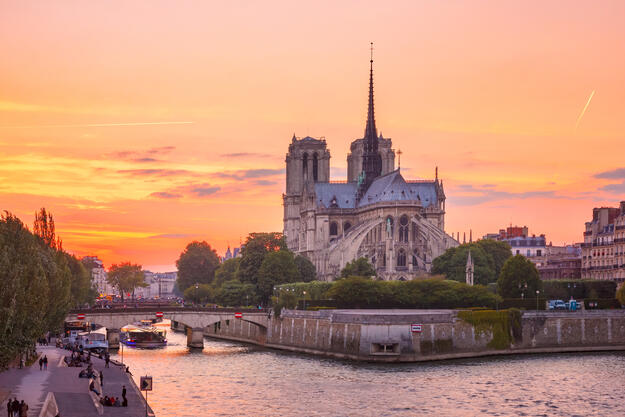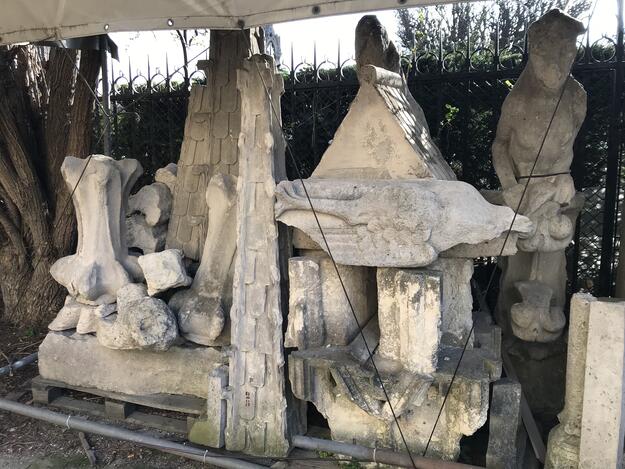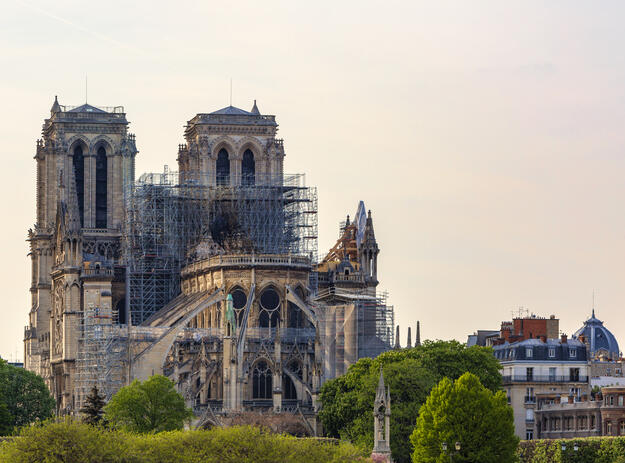Notre-Dame of Paris
Site History and Significance
A Gothic Masterpiece
The construction the Notre-Dame of Paris medieval cathedral began in 1163 and is considered to have been completed in the thirteenth century. Although the structure was modified multiple times in the following centuries, it remains a stunning example of Gothic architecture with distinctive flying buttresses, Gothic towers, a central spire, and large rose windows.
A UNESCO World Heritage site since 1991, the cathedral of Notre-Dame served as the coronation site for Napoleon I in 1804 and later as a funeral site for various French presidents. The inspiration for Victor Hugo’s world famous novel The Hunchback of Notre Dame and countless other literary and artistic masterpieces, Notre-Dame is an icon recognized all over the world.
The Near-Loss of a Global Icon
On the evening of April 15, 2019, a conflagration rapidly consumed the roof of Notre-Dame. The beloved landmark was saved from collapse thanks to a skillful effort to extinguish the fire. An international outpouring of sympathy for the citizens of Paris and all of France followed, as the near loss of this universal masterpiece was a reminder of the depth of human connection to heritage places. In France, a resolute commitment to rebuild was buoyed by private donations, ranging from small amounts to pledges for hundreds of millions of euros.
The suggestion that rebuilding might deviate from the historic form of the roof and spire prompted fervent debate. While many emphasized the importance of recreating the well-known form of the cathedral in the cityscape, others favored the symbolic potential of a new, contemporary design for the roof and spire. The catastrophic event further underscored the importance of emergency preparedness and accurate risk assessment in the wake of other high-profile blazes including the Mackintosh Building of the Glasgow School of Art and the National Museum of Brazil in Rio de Janeiro.
Our Involvement
2020 World Monuments Watch
Today, the stability of the structure remains precarious. Structural shoring has been installed throughout the shell of the building, while the disfigured remains of the scaffolding that had been installed for restoration prior to the fire will take many months to remove. At the same time, concerns for worker safety arising from the likely concentration of lead dust around the area in need of repair means that work must proceed at a slower pace. The process of salvaging, planning, and rebuilding is sure to take years, delaying the return of this beloved cathedral to the community of worshippers, citizens, and other visitors. Notre-Dame of Paris was included on the 2020 World Monuments Watch to lend moral support and solidarity to experts, workers, and the concerned public on the long road ahead.
Fire Prevention and Capacity Building
After Notre-Dame's inclusion on the 2020 Watch, WMF began developing a fire risk management workshop. Designed to raise awareness of fire-related threats and prevention strategies, the workshops will build capacity among stakeholders to advance the protection of cultural heritage from fire.
WMF has also compiled a compendium of resources on fire protection for heritage places.
Learn more
World Monuments Fund safeguards cultural heritage around the globe, ensuring our treasured places are preserved for present and future generations.
Sign up for our newsletter to receive regular updates on our projects, stories from the field, upcoming events, and more!
![]()
World Monuments Fund’s work at Notre-Dame of Paris has been made possible, in part, by support from American Express and The Selz Foundation.



